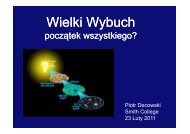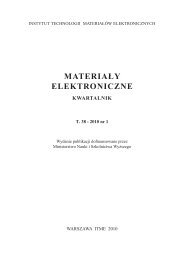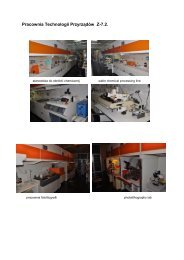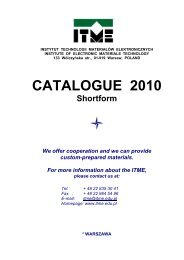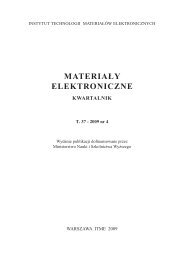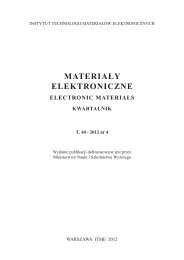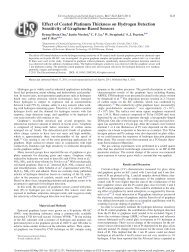MATERIAÅY ELEKTRONICZNE - ITME
MATERIAÅY ELEKTRONICZNE - ITME
MATERIAÅY ELEKTRONICZNE - ITME
You also want an ePaper? Increase the reach of your titles
YUMPU automatically turns print PDFs into web optimized ePapers that Google loves.
Deep-level defects in epitaxial 4H-SiC irradiated...<br />
ferent levels of nitrogen concentration, the C/Si ratio<br />
was maintained for all growth processes at 1.55. The<br />
epitaxial layers consisted of an initial 5 μm thick n +<br />
(~1×10 18 cm -3 ) buffer layer grown at 5 μm/h, followed<br />
by a 20 μm thick layer grown at 10 μm/h. Deep<br />
defect centers were studied in the layers obtained in<br />
two selected epitaxial processes labeled as C1061215<br />
(epilayer A) and C1070714 (epilayer B).<br />
Schottky diodes for DLTS measurements were<br />
prepared by evaporating a 20-nm film of Cr and<br />
a 300-nm film of Au on the surface of the epitaxial<br />
4H-SiC. The Schottky contacts were deposited<br />
through a metal shadow mask with a diameter of<br />
0.5 mm. Large-area Ohmic Al contacts were deposited<br />
on the back side of the wafer by electron beam<br />
evaporation. The sample with the contacts was cut<br />
into chips of 5x5 mm 2 in area that were subsequently<br />
used for measurements of the capacitance-voltage<br />
(C-V) characteristics and for DLTS experiments.<br />
The DLTS spectra were taken between 150 and<br />
700 K at a reverse bias V R<br />
= -10 V, a filling pulse<br />
amplitude V F<br />
= 10 V and a filling pulse duration time<br />
t c<br />
= 100 μs. The measurements were carried out using<br />
as-grown samples, as well as those subjected to the<br />
bombardment with 300-keV electrons, performed in<br />
a van de Graff accelerator at room temperature with<br />
a dose of ~ 1×10 17 cm -2 . The DLTS system used in the<br />
present work and the procedures used for determination<br />
of the trap activation energy, apparent capture<br />
cross-section and concentration have been described<br />
elsewhere [5]. The net donor concentrations obtained<br />
from the C-V measurements on as-grown epilayers<br />
A and B were equal to 1.0 × 10 15 and 3.5 × 10 15 cm -3 ,<br />
respectively. The residual nitrogen concentrations<br />
in the epilayers, determined by Secondary Ion<br />
Mass Spectroscopy (SIMS), were 1.1 × 10 15 and<br />
4.0 × 10 15 cm -3 , respectively.<br />
Charge carrier lifetime measurements were performed<br />
via microwave photoconductance decay (μ-<br />
-PCD). The 355-nm line of a tripled Nd:YAG pulsed<br />
laser was used to excite electron hole pairs within<br />
the epitaxial layer, while the lifetime was determined<br />
through the measurement of the time constant of the<br />
exponential decay of the reflected microwave signal<br />
power. Lifetime mapping on the wafer was performed<br />
using a Semilab WT-85 lifetime scanner where<br />
the excitation pulse width is 10 ns and the frequency<br />
of the reflected microwave signal is in the range of<br />
10.0 - 10.6 GHz.<br />
III. RESULTS AND DISCUSSION<br />
A. Deep-level defects in as-grown material<br />
DLTS spectra typical of the as-grown epilayers A<br />
and B, with the nitrogen concentrations of 1.1×10 15<br />
and 4×10 15 cm -3 , respectively, are presented in<br />
Fig. 1 and the images illustrating the distributions<br />
Fig. 1. DLTS spectra typical of the as-grown epilayers<br />
A (left) and B (right) with the nitrogen concentrations<br />
1.1 × 10 15 cm -3 and 4.0×10 15 cm -3 , respectively.<br />
Rys. 1. Widma DLTS typowe dla warstw epitaksjalnych<br />
z grupy A (strona lewa) oraz z grupy B (strona prawa),<br />
w których koncentracja azotu wynosiła odpowiednio<br />
1,1 x 10 15 cm -3 i 4,0 x 10 15 cm -3 .<br />
of minority carrier lifetime in various regions of the<br />
epilayers are shown in Fig. 2. According to the DLTS<br />
results, in the both epilayers only the Z 1/2<br />
center is<br />
observed. The concentrations of this center in the<br />
epilayers A and B are found to be 1.8 × 10 12 and<br />
3.4 × 10 12 cm -3 , respectively. As seen in Fig. 2, the<br />
minority carrier lifetime for approximately 60% of<br />
the epilayer A area is ~ 970 ns and for around 70%<br />
28




